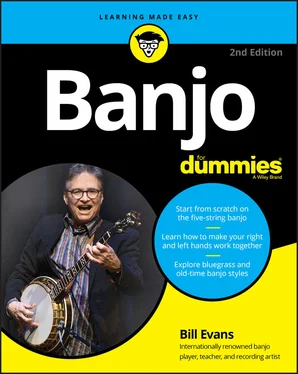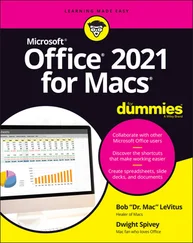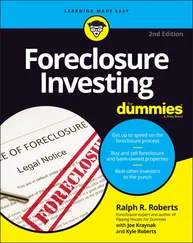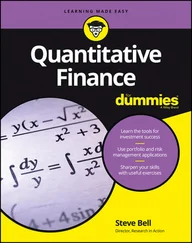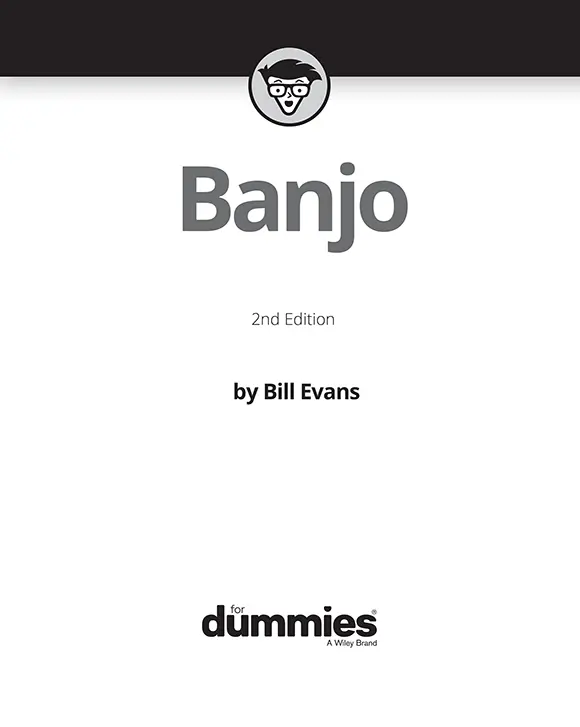
Banjo For Dummies®, 2nd Edition
Published by: John Wiley & Sons, Inc.,111 River Street, Hoboken, NJ 07030-5774, www.wiley.com
Copyright © 2020 by John Wiley & Sons, Inc., Hoboken, New Jersey
Media and software compilation copyright © 2020 by John Wiley & Sons, Inc. All rights reserved.
Published simultaneously in Canada
No part of this publication may be reproduced, stored in a retrieval system or transmitted in any form or by any means, electronic, mechanical, photocopying, recording, scanning or otherwise, except as permitted under Sections 107 or 108 of the 1976 United States Copyright Act, without the prior written permission of the Publisher. Requests to the Publisher for permission should be addressed to the Permissions Department, John Wiley & Sons, Inc., 111 River Street, Hoboken, NJ 07030, (201) 748-6011, fax (201) 748-6008, or online at http://www.wiley.com/go/permissions .
Trademarks:Wiley, For Dummies, the Dummies Man logo, Dummies.com, Making Everything Easier, and related trade dress are trademarks or registered trademarks of John Wiley & Sons, Inc., and may not be used without written permission. All other trademarks are the property of their respective owners. John Wiley & Sons, Inc., is not associated with any product or vendor mentioned in this book.
LIMIT OF LIABILITY/DISCLAIMER OF WARRANTY: WHILE THE PUBLISHER AND AUTHOR HAVE USED THEIR BEST EFFORTS IN PREPARING THIS BOOK, THEY MAKE NO REPRESENTATIONS OR WARRANTIES WITH RESPECT TO THE ACCURACY OR COMPLETENESS OF THE CONTENTS OF THIS BOOK AND SPECIFICALLY DISCLAIM ANY IMPLIED WARRANTIES OF MERCHANTABILITY OR FITNESS FOR A PARTICULAR PURPOSE. NO WARRANTY MAY BE CREATED OR EXTENDED BY SALES REPRESENTATIVES OR WRITTEN SALES MATERIALS. THE ADVICE AND STRATEGIES CONTAINED HEREIN MAY NOT BE SUITABLE FOR YOUR SITUATION. YOU SHOULD CONSULT WITH A PROFESSIONAL WHERE APPROPRIATE. NEITHER THE PUBLISHER NOR THE AUTHOR SHALL BE LIABLE FOR DAMAGES ARISING HEREFROM.
For general information on our other products and services, please contact our Customer Care Department within the U.S. at 877-762-2974, outside the U.S. at 317-572-3993, or fax 317-572-4002. For technical support, please visit www.wiley.com/techsupport .
Wiley publishes in a variety of print and electronic formats and by print-on-demand. Some material included with standard print versions of this book may not be included in e-books or in print-on-demand. If this book refers to media such as a CD or DVD that is not included in the version you purchased, you may download this material at http://booksupport.wiley.com . For more information about Wiley products, visit www.wiley.com .
Library of Congress Control Number: 2020945190
ISBN 978-1-119-73138-2 (pbk); ISBN 978-1-119-73139-9 (ebk); ISBN 978-1-119-73140-5 (ebk)
Banjo For Dummies®
To view this book's Cheat Sheet, simply go to www.dummies.comand search for “Banjo For Dummies Cheat Sheet” in the Search box.
Table of Contents
1 Cover
2 Introduction Introduction You just can't get that wild and complex sound out of your head. You thought about trying to play, and you ended up here — with a copy of Banjo For Dummies in your hands. It's time to join the hundreds of thousands of other players all over the world who can't get enough of one of the world's most unique and loved instruments. You're ready to play the five-string banjo. You've probably already come to the realization that no matter what you may have seen on television or in old movies, real banjo players aren't comedic rubes or country bumpkins. They're folks just like you and me from all walks of life who at some point heard the sound of a banjo and said to themselves, “That's for me!” While the five-string banjo is usually associated with bluegrass, folk, and country music, these days musicians play just about any kind of music on the banjo — from rock to jazz to classical and everything in between. You can use the banjo to accompany songs around a campfire or to play a Bach partita. You can play anything on a five-string banjo. It's time to get started!
About This Book Foolish Assumptions Icons Used in This Book Beyond the Book Where to Go from Here
3 Part 1: The Amazing Five-String Banjo Chapter 1: You Want to Play What?: Banjo Basics Getting into Banjo Identifying Different Kinds of Banjos Knowing the Parts of a Banjo Becoming a Banjo Player Chapter 2: Tuning Your Banjo G Tuning: Getting Your Strings in Order Relative Tuning: Tuning the Banjo to Itself Reference Tuning: Getting a Little Outside Help Chapter 3: Starting to Play: Fretting and Strumming Talking Banjo Talk Positioning Body and Banjo Fretting with the Left Hand Fingering G, D7, and C Chords Checking Out Chord Diagrams Chord Progressions: Playing Your First Song Chapter 4: Playing by the Rules: Songs and Tablature Breaking Down the Parts of a Song Reading Tablature Playing Pinch Patterns Being a Great Team Player
4 Part 2: Let's Pick! Basic Banjo Techniques Chapter 5: Getting Right with the Right Hand Clawhammer and Bluegrass: Down-Picking and Up-Picking Clawhammer Right-Hand Basics Bluegrass Right-Hand Basics Chapter 6: Sliding, Hammering, and Pulling: Adding the Left Hand Slipping into the Slide Nailing the Hammer-On Pulling Off the Pull-Off Bending the Chokes Putting Your Hands Together Chapter 7: Working Up Your First Tunes: Clawhammer and Bluegrass Stylin’ It: Playing Real Banjo Music Tackling a Few More Tunes
5 Part 3: Playing Styles Past, Present, and Future Chapter 8: Playing the Old-Time Way: Clawhammer and Traditional Styles Digging Deeper into Clawhammer Banjo Discovering Four Clawhammer Classics Discovering Pete Seeger–Style Banjo Fingerpicking the Old-Time Way Chapter 9: Playing Three-Finger Styles: Scruggs, Melodic, and Single String Playing Scruggs-Style Banjo Making Music with Melodic Banjo Playing Single-String Banjo Combining Three-Finger Techniques Chapter 10: Playing Up-the-Neck Backup: Chords and Vamping Playing Movable Major Chords Playing Movable Minor Chords Using Vamping in Backup Playing Knowing When to Use Vamping Chapter 11: Playing Historical Styles: African, Minstrel, and Classic Banjo Exploring African-American Banjo Roots Converging Cultures: The World of Minstrel Banjo Branching Out with Classic Banjo Chapter 12: Networking into Banjo Culture Taking Private Lessons Playing Music with Others Attending Workshops and Camps Heading to a Bluegrass Festival
6 Part 4: Buying a Banjo and Keeping It in Good Shape Chapter 13: Finding Your Banjo Bliss: A Buyer's Guide Establishing Your Banjo Boundaries Making the Leap: Resonator or Open-Back? Finding a Great Beginner’s Banjo Stepping Up to a Better Banjo Finding the Right Music Store Chapter 14: Getting the Right Stuff: Banjo Gear Picking Up the Stuff You Really Need Collecting More Cool Tools to Help Your Playing Chapter 15: Taking Care of Your Baby: String Changing and Basic Maintenance Replacing Banjo Strings Setting the Bridge Adjusting Head Tension Keeping Your Banjo Looking Its Best Knowing When to Consult a Professional
7 Part 5: The Part of Tens Chapter 16: Ten Tips to Make Practicing More Fun Practice Regularly Set Goals Warm Up Use Tablature Sparingly Get the Right Hand First Gradually Increase Your Speed Take Songs One Measure at a Time Play the Right Repertoire Listen Actively Keep Track of Your Progress Chapter 17: Ten Great Banjo Players You Need to Hear Earl Scruggs (1924–2012) Pete Seeger (1919–2014) Béla Fleck (b. 1958) Bill Keith (1939–2015) Mike Seeger (1933–2009) Don Reno (1927–1984) J. D. Crowe (b. 1937) Tony Trischka (b. 1949) Alison Brown (b. 1962) Jens Kruger (b. 1962)
Читать дальше
